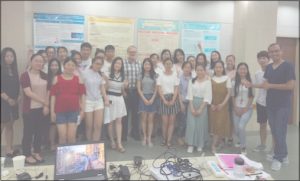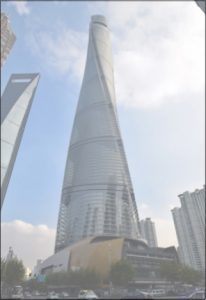I’ve had a great time here in Wuxi, learned lots, met new friends and hopefully helped a class of grad students enlarge their research perspective using design-based research. I also did two presentations here at Jiangnan University for faculty and students. The first was on Publishing in International Academic Journals and the second on MOOC Possibilities.
The Master’s degree class ended with the First China-Canada Student Poster conference. Each of 8 student groups created (in English) and presented (In Chinese) their proposals for a design based research project. Each project had to have a discussion of the context,

Final Day of Class with Poster Conference
a description of the intervention, the means of assessing learning, answering of research questions and a start at development of design principles from lessons learned. I’m not sure if any of these projects will actually be enacted, but I think it was useful to explore research designs beyond the positivist paradigm that defines current research study here. Of course, every good conference ends with a social and I ordered in pizza and pop for all.
I also made time, with a few new friends, to visit Shanghai. We visited the Shanghai Tower which has recently opened and brags of being the second tallest building in the world. As

Shanghai Tower
expected the view from the 125 floor observation deck was spectacular – but if only the smog didn’t obscure the vista! I was impressed with the eco-friendliness, the elevators (40 MPH) and the design of the building. The whole building twists 120 degrees as it ascends, making for interesting lines and greatly reducing the wind forces on the tower. Given increasing number of global weather extremes this is important for such enormous structures. The Tower also gathers and recycles all rainwater and has over 200 wind turbines in the top section of the tower to generate electricity.
We also visited a famous EdTech researcher (Prof Gu) at East China Normal University in Shanghai and talked about her editing of a new journal, distance education woes and the possibility of me making longer visits to that campus.
So what’s to learn? My visit this time was in the more prosperous and populated parts of China, however, like Canada, there is a much more to see and learn about than visiting in large cities. The people I met were really hard working, seemed relatively happy and clearly focussed on succeeding and building their own and China’s continued prosperity. Despite the pervasiveness of mobile media, traditional values like respecting elders and those with authority remain firmly entrenched. There seems to be lots of support for the current President and little open discontent with anything -including the air quality. There is also great complacency with the way the “rules” for everything from travel, to media, to employment regulations seem to arbitrarily change and most I talked to are more concerned with knowing and following whatever the current rules are than in opposing them. Of course, perhaps western ideas of open discontent are sparse because they are clamped down on by authorities. Nonetheless, those waiting for the Chinese to rise up against their ‘undemocratic’ government will likely have a VERY long wait.
By using a VPN, I was able to use all of the Internet tools that I have access to in Canada – and I had more time on my own to get papers, presentations finished ans watch Netflix! Reading in the China Daily press (owned of course by the government) I learned that China is enacting new sets of Internet controls and supposedly engaged in public consultations. The blocking of Google sites and most social media, has resulted in the growth of equivalent Chinese applications – some of which like cell phone payment systems are much more popular (and better?) than those used in Canada. However, China has a national goal to be A (or THE) world leader in technology development by 2050 and is investing appropriately. The recent exit of the US from global climate agreements provides even more incentive and opportunity for China to play a world leading role in this and other tech-enhanced ventures. Unfortunately, I think the blocking of some educational sites (notably Google Scholar, but also Slideshare, YouTube and others) is counter-productive to China’s aspirations. I hope that “public consultation” (whatever that means) will result in more selective opening of certain sites and especially those with large educational and research value.
My wise older brother commented after my earlier post on my encounters with the Chinese medical system, that I had better be careful about too strong advocacy of pay for service medicine. My experience was minor and paid for easily by my Western income. What impressed me was the speed and efficiency of their system. But I am also aware that for many, the fees that were ‘pocket change’ for me, are real obstacles for others. I didn’t see a single pan handler or beggar here in China, but I did see a display at a mall of pictures of a very young boy and his Aunt soliciting money to pay for his cancer treatments. So, despite the challenges we have funding health services in Canada I remain convinced that full, public funding is the best alternative for everyone’s health and well-being.
So home tomorrow and I’ll be glad to see Sue, the ol’ neighbourhood and old friends. Thanks for reading. – comments welcomed.
Thanks for taking us along on this journey, Terry. It has been interesting.